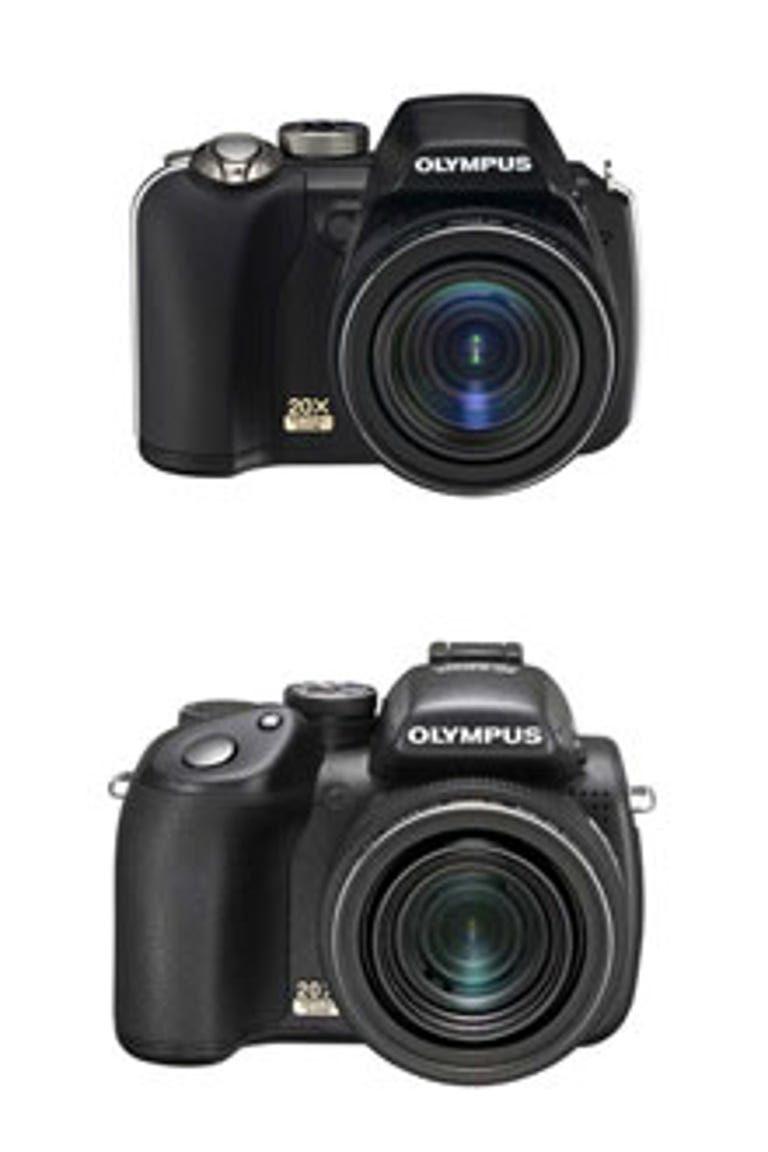 Why You Can Trust CNET
Why You Can Trust CNET Olympus SP-565 Ultra Zoom review: Olympus SP-565 Ultra Zoom
With 20x optical zoom and a tiny footprint, the SP-565 UZ is a competent superzoom, let down by some lens and picture issues.
Editor's note: The SP-565UZ has replaced the SP-560UZ and the SP-570UZ in the Olympus superzoom range.
The Good
The Bad
The Bottom Line
Design
Sharing the same feature set as the recently reviewed SP-570UZ, the 560UZ is a more compact and stylish version than the top-of-the-line model. There's a 2.5-inch LCD, rather than the 2.7-inch found on the 570, and the entire body is slimmer, lighter and more portable.

The body is textured in the typical Olympus black plastic finish. Buttons and dials are all nicely coated in silver edges, and are responsive to press. The zoom rocker and the mode dial are both very nice indeed, providing precise feedback when used. Olympus are still touting their proprietary xD picture card format, though it may be slowly phased out given that most new models in their range are compatible with micro SD cards.
It's much more of a point and shoot than the 570, with 30 scene modes to choose from and a more streamlined look and feel. That said, there are still full manual controls on the 565, with all the standard exposure modes present on the mode dial.
One of the only problems we had with the design of the 565 is the lens cap. Feeling more like a plastic bottle cap than a lens protector, it sits over the outside of the unit. This is mostly a problem when turning the camera on — the lens cap doesn't pop off, or extend with the lens as with other superzoom models we've tested (such as the Canon PowerShot SX10 IS) — bad news for shooters who forget to take the lens cap off. The cap actually stops the lens from extending, which can't be good for the camera.
We also liked the included camera pouch — a little touch, but a significant one given that most manufacturers ignore this.
Features
Olympus used to hold the record for the longest zoom available in a non-dSLR camera, at 20x. As more and more superzoom manufacturers equal this length, the 565 certainly can't compete on this level alone — but unfortunately there doesn't seem to be many points of difference, feature-wise, between the Olympus and other superzooms.
The 565's lens is a pleasingly wide 26mm that extends all the way to 520mm. We also enjoyed the maximum aperture of f/2.8- f/4.5. There's also the ability to shoot in the RAW file format, as well as standard JPEG, and the camera runs on four AA batteries, as is the same with most superzooms. Face detection on the Olympus has been amped up, and the 565 can now register up to 16 individual faces in the one frame and adjust the exposure accordingly.
Performance and Image Quality
Taking the extensive lens range into consideration, we were incredibly surprised by just how quiet its operation was. The initial extension when starting up was nearly whisper quiet, and it continued to be very unobtrusive throughout our tests. Also, at maximum extension, the lens delivered surprisingly sharp results with accurate colours.
Unfortunately, this is where all that lens praise ends. At the widest angle, it produced very pronounced barrel distortion — that is, lines that should have been straight, appeared to curve in and out toward the edges of the frame. While this isn't uncommon on cameras of its type, the Olympus severely distorted straight lines. We took a picture of a flight of stairs whilst standing right in front of it and discovered that the straight stairs looked almost curved when we reviewed them. See the picture below for an example.
The 565, like the SX10 IS, also overexposed a lot of its shots in automatic mode, on the default metering setting. Noise levels were acceptable across the range, though at ISO 1600 and above, there was significant loss of detail as objects that were clear at lower ISO levels practically vanished in a sea of noise.
The screen is difficult to see outdoors in overcast situations, though not as troublesome as Canon's effort. Colours were pleasing overall; not too saturated and definitely erring on the cautious rather than rambunctious side. There was, however, a significant amount of chromatic aberration just like the shots from the 570. It didn't always demonstrate itself as the usual purple fringing though; often it was cyan or looked like glare against high contrast areas.
Conclusion
Compared to the other superzoom cameras we've tested, such as the Canon SX10 IS, the Olympus SP-565 UZ certainly held its ground. There are a couple of differences that may sway a photographer to choose one over the other — the Olympus looks much more compact and weighs a bit less, but it does have lens issues that aren't as apparent on the SX10.


